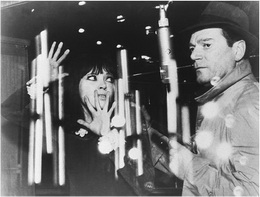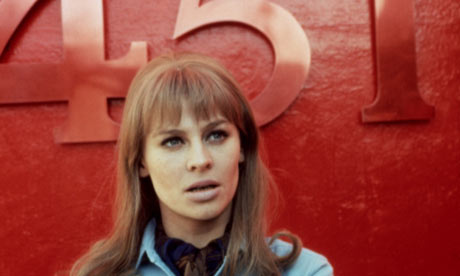So I was searching far and wide through the site and discovered no talk of the French New Wave! At least through the search tab. Any respectable film forum such as this one should have a page dedicated to this radical, historic movement in cinema. Many of you seem extremely knowledgeable in film and film history, so you may already know about this cinematic revolution. But for those of you who don't, here's a brief history.


Truffaut's Jules et Jim (left) and The 400 Blows
Starting in the mid-1950's the highly influential film magazine Cahiers du cinema revolutionized the way films were watched. The team of critics for the magazine was a veritable who's-who list of great French directors. Among them were Jean-Luc Godard, Francois Truffaut, Andre Bazin, Claude Chabrol, Eric Rohmer, Jean-Pierre Melville... the list goes on and on. Anyway, these critics reevaluated classic Hollywood films and found a new way of analyzing them-exclusively through the director.
Before this time, directors of course were mentioned, but hardly considered the most important player in a production-that was usually the producer. These French New Wave critics/directors saw something entirely different. Francois Truffaut, who essentially invented the auteur theory of film criticism, reevaluated the works of Hollywood directors working in the studio system, championing many of their works as true works of art and not just commercial products. This was a radical notion given the culture of grand productions and the Golden Age of Hollywood.


Jean Paul Belmondo and Jean Seberg in Breathless; Hiroshima Mon Amour
It was in this magazine that directors like Alfred Hitchcock, Nicholas Ray, and Howard Hawks were rediscovered for their artistic merit, and their unique individual styles in telling any story. In fact, for these iconoclasts of criticism, the story hardly mattered; what did matter was the style in which the director told it, how they made it their own.
So why is Cahiers du cinema relevant to any discussion on the French New Wave? Because without it, there would not have been one. When Truffaut, Chabrol, and Godard decided to stop criticizing movies and start making them, they applied their new take on film theory to their highly personal, often autobiographical films. And with those jarring, completely fresh jump-cuts in Breathless, and the existential yearnings of a delinquent French youth in The 400 Blows, the auteurs heralded a new movement.
What techniques in film did the movement introduce? Basically the entire film-making process was a radical shift from the norm. Shots were lingering and camera movement was much freer, often breaking conventional rules of filming methods. Largely improvised dialogue was popular, characters stepping outside a scene to directly address the audience started here, entire productions were treated as free-form jazz exercises, with directors improvising scenes, bouncing ideas off their equally radical DP's and actors.
In a time when French cinema, nearly all popular cinema, was formulaic and bound by story, these directors sought to breath new life into the medium by playing off audience expectations. Soon, the whole world caught on and a fresh batch of American directors were ready to display their distinct style in film-making. Focus shifted from finding the most lucid, logical way of relating a story to finding the most artistic way. The literal plot was important, but the symbolic use of camera techniques to explore a film's themes was paramount.
Well, this actually went on longer than I intended, sorry. I actually mean for this thread to be a place where people can talk about movies they've seen from the movement, ask questions about it, offer recommendations and talk about famous figures of that era.


Truffaut's Jules et Jim (left) and The 400 Blows
Starting in the mid-1950's the highly influential film magazine Cahiers du cinema revolutionized the way films were watched. The team of critics for the magazine was a veritable who's-who list of great French directors. Among them were Jean-Luc Godard, Francois Truffaut, Andre Bazin, Claude Chabrol, Eric Rohmer, Jean-Pierre Melville... the list goes on and on. Anyway, these critics reevaluated classic Hollywood films and found a new way of analyzing them-exclusively through the director.
Before this time, directors of course were mentioned, but hardly considered the most important player in a production-that was usually the producer. These French New Wave critics/directors saw something entirely different. Francois Truffaut, who essentially invented the auteur theory of film criticism, reevaluated the works of Hollywood directors working in the studio system, championing many of their works as true works of art and not just commercial products. This was a radical notion given the culture of grand productions and the Golden Age of Hollywood.


Jean Paul Belmondo and Jean Seberg in Breathless; Hiroshima Mon Amour
It was in this magazine that directors like Alfred Hitchcock, Nicholas Ray, and Howard Hawks were rediscovered for their artistic merit, and their unique individual styles in telling any story. In fact, for these iconoclasts of criticism, the story hardly mattered; what did matter was the style in which the director told it, how they made it their own.
So why is Cahiers du cinema relevant to any discussion on the French New Wave? Because without it, there would not have been one. When Truffaut, Chabrol, and Godard decided to stop criticizing movies and start making them, they applied their new take on film theory to their highly personal, often autobiographical films. And with those jarring, completely fresh jump-cuts in Breathless, and the existential yearnings of a delinquent French youth in The 400 Blows, the auteurs heralded a new movement.
What techniques in film did the movement introduce? Basically the entire film-making process was a radical shift from the norm. Shots were lingering and camera movement was much freer, often breaking conventional rules of filming methods. Largely improvised dialogue was popular, characters stepping outside a scene to directly address the audience started here, entire productions were treated as free-form jazz exercises, with directors improvising scenes, bouncing ideas off their equally radical DP's and actors.
In a time when French cinema, nearly all popular cinema, was formulaic and bound by story, these directors sought to breath new life into the medium by playing off audience expectations. Soon, the whole world caught on and a fresh batch of American directors were ready to display their distinct style in film-making. Focus shifted from finding the most lucid, logical way of relating a story to finding the most artistic way. The literal plot was important, but the symbolic use of camera techniques to explore a film's themes was paramount.
Well, this actually went on longer than I intended, sorry. I actually mean for this thread to be a place where people can talk about movies they've seen from the movement, ask questions about it, offer recommendations and talk about famous figures of that era.
__________________
"I want a film I watch to express either the joy of making cinema or the anguish of making cinema" -Francois Truffaut
"I want a film I watch to express either the joy of making cinema or the anguish of making cinema" -Francois Truffaut
Last edited by Cries&Whispers; 06-30-10 at 05:51 AM.









